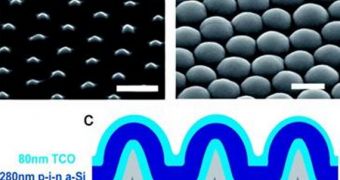Solar power is the most abundant source of renewable energy in the world today, rivaled only by wind power and geothermal energy. The Sun will indeed rise every day when expected, at least for the next four to five billion years, so harvesting its energy is a long-term objective. Existing solar cells can easily trap and store sunlight into electricity, but their main disadvantage is that they do so inefficiently. That is to say, only a small portion of the light reaching them gets converted. Additionally, water and dust depositing on the cells cause even more troubles. But a solution to all this is in the works.
Scientists at the Stanford University have recently developed a new technology, which allows experts to produce solar cells that have billions and billions of nanoscale, dome-like structures on their surfaces. The tiny domes are used as some sort of “janitors,” as they are able to both boost the efficiency of the cells, and to remove water and dust from the panels. Self-cleaning solar cells, the team says, could make all the difference in the future, as the world moves from a carbon-based economy, to one based on renewable sources.
The scientists also say that the nanoscale dome patterns are not just applied to the top layer of the solar cells, but to each and every one of them, right down to the base of the cells. The latter are themselves placed on a substrate that is patterned with cone-like structures at the nanoscale, Technology Review reports. The substrate itself acts like a light reflector and electrical contact, in spite of being just 100 nanometers thick. Overall, the appearance of the cells reminds experts of the dome-like mushroom structures that other research groups around the world are developing for other self-cleaning materials such as advanced paints.
Details of the SU accomplishment appear in the latest issue of the respected scientific journal Nano Letters, a publication of the American Chemical Society (ACS). The lead investigator of the research has been Stanford Materials Science Professor Yi Cui. He believes that the nanoscale patterns could successfully be employed in other types of materials as well, potentially leading to groundbreaking innovations in different fields of research.

 14 DAY TRIAL //
14 DAY TRIAL //